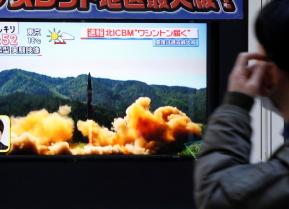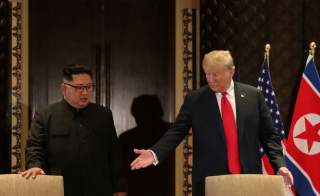North Korea and America’s Second Summit: Here’s What David Santoro Thinks Will Happen
"An unsuccessful second summit would involve engaging in trade-offs without a roadmap and implementation process."
Editor’s Note: Want more ideas on what will happen at the summit? Check out all 76 expert opinions we gathered here.
The 2018 Trump-Kim Singapore Summit and high-level dialogue established between North and South Korea have helped end tensions on the Korean Peninsula. Pyongyang hasn’t conducted nuclear or missile tests since, and détente has taken hold.
North Korea hasn’t moved closer to denuclearization, however, because the Singapore Joint Statement is unclear about denuclearization, because there is no action plan, and because U.S. attempts to establish an implementation process after the summit have failed. This has enabled Kim Jong-un to take only symbolic actions, such as destroying nuclear and missile sites, while continuing to expand his arsenal.
The unspecified sequence for implementation of the Joint Statement’s provisions have also enabled Kim Jong-un to launch a peace offensive toward South Korea, China, and Russia to turn the table to his advantage; Seoul has been receptive and has also promoted peace. Kim Jong-un is now pressuring Washington to deliver on the Joint Statement’s promises to normalize U.S.-North Korea relations and establish peace on the Peninsula, which would translate into the removal of sanctions and an end to the US-South Korea alliance and US presence in South Korea.
What can a second Trump-Kim summit produce? There can be good, bad, or ugly developments.
The good. A successful second summit would include an action plan with milestones to sequence and achieve denuclearization and peace, and the establishment of working groups to implement that plan. That would require give-and-take exchanges and, for Washington, abandonment of its denuclearization-first strategy, which hasn’t worked. Washington would have to make concessions before Pyongyang abandons its nuclear arsenal. Similarly, Pyongyang would have to make concessions before there is a peace treaty.
The bad. An unsuccessful second summit would involve engaging in trade-offs without a roadmap and implementation process. Accepting and rewarding a one-off concession from Pyongyang on Yongbyon, for instance, would not eliminate North Korea’s nuclear arsenal, or its ability to perfect it. Yet this would enable Kim Jong-un to advance his peace offensive. Similarly, a one-off U.S. concession, however major, is unlikely to lead to North Korea’s denuclearization and could weaken Washington’s leverage on Pyongyang.
The ugly. A catastrophic second summit would involve a failure to agree on anything and lead to a breakdown of talks, more North Korean nuclear and missile tests, and escalating tensions with the United States. In addition to opening the door to another war on the Peninsula (one that could include nuclear use), such an outcome would distract from Washington’s stated primary focus: China.
David Santoro is the Director and Senior Fellow of Nuclear Policy at Pacific Forum. He has previously worked on nuclear policy issues around the world and been the Stanton Nuclear Security Fellow at the International Institute for Strategic Studies in London. You can follow him on Twitter @DavidSantoro1.
Image: Reuters


